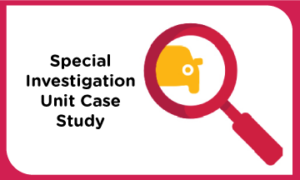The Coalition Against Insurance Fraud estimates that at least $308.6 Billion is stolen yearly through insurance fraud, costing the average household an estimated $1,000 extra in insurance premiums each year to make up for that fraud. We take insurance fraud seriously and have implemented measures to ensure that payments are made only on legitimate claims. When fraud is suspected, claims are sent to our Special Investigations Unit (SIU) for further examination.
Recently, Maryland Auto investigated a claim in which the policyholder reported that they struck a tree while avoiding a deer in snowy conditions and, as a result, sustained damage to the front end of their vehicle.
What makes this case noteworthy is that approximately six weeks earlier, the same vehicle was involved in a single-vehicle accident in which the policyholder reported sliding off the road and striking a tree, causing damage to the front end of the car. At the time of the first accident and claim, the policy only included liability coverage, which covers damage to other vehicles and property, but not to the covered vehicle.
Two weeks before the second claim, the policyholder added comprehensive and collision coverages which would cover damage to the insured vehicle. Adding additional coverages shortly before a reported accident is what fraud investigators refer to as a “suspicious loss indicator” – or red flag.
During the investigation of the second claim, the policyholder stated the damage from the first incident was merely cosmetic and was repaired by a friend, whose contact information they could not provide.
The adjuster referred the case to our Special Investigations Unit. The SIU investigation revealed a different story.
The investigator conducted a license plate reader search on the insured vehicle. License plate readers are computer-controlled cameras that capture license plates and photos of vehicles as they pass the camera. These cameras are positioned along roadways and can be mounted in places such as toll lanes, streetlights, highway overpasses, and even on police cars. The search produced photos of the front end of the policyholder’s vehicle, taken shortly after the first incident. The images showed significant damage consistent with impact against a pole or tree, not just superficial damage as was reported.
In addition, during the period between the first incident and filing the second claim, the policyholder received a ticket for a wrecked vehicle parked on a roadway. The traffic ticket included photos showing the same front-end damage, corroborating the license plate reader finding. This citation is may have prompted the policyholder to add collision coverage and submit a false claim, hoping to have the original damage repaired to avoid additional citations.
Upon physical inspection, the SIU investigator confirmed that the existing damage on the vehicle was consistent with the photos from both the tag trace and traffic ticket records, indicating the damage predated the second claim. In addition, Maryland Auto’s estimator verified this consistency across all photographic evidence.
Due to the discrepancies and questionable facts, the claim was denied, and Maryland Auto forwarded the case to the Maryland Insurance Administration’s Insurance Fraud Division for further investigation.
This claim demonstrates Maryland Auto’s commitment to fraud prevention, highlighting the diligent work of our adjusters in flagging suspicious activity and the SIU’s ability to conduct a thorough investigation. This ultimately prevented the payment of a fraudulent claim.




